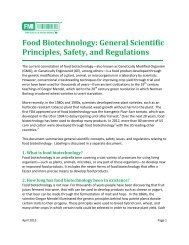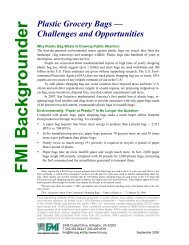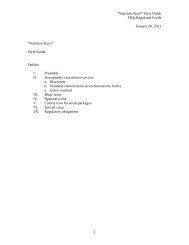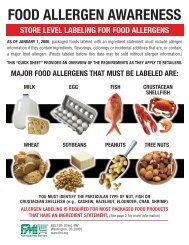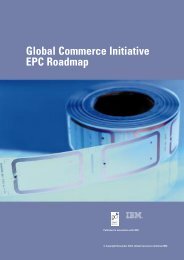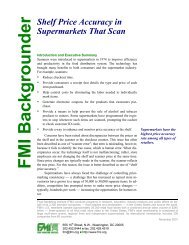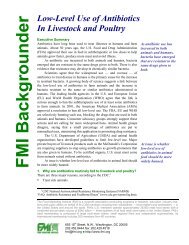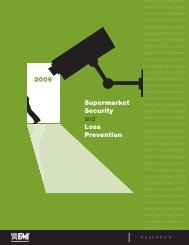Consumer Shopping Habits for Wellness and Environmentally ...
Consumer Shopping Habits for Wellness and Environmentally ...
Consumer Shopping Habits for Wellness and Environmentally ...
Create successful ePaper yourself
Turn your PDF publications into a flip-book with our unique Google optimized e-Paper software.
u Top health conditions reported, in order, include overweight, stress, arthritis, depression, diagnosed digestive<br />
disorders, <strong>and</strong> anxiety. It is interesting to note that several of these are not acute medical conditions, but more<br />
lifestyle-related.<br />
u There are few H+W “negatives” of much substance, though Periphery consumers‘ worries about price <strong>and</strong> frustration<br />
with H+W shopping due to lack of H+W knowledge could readily be interpreted as negatives. Mid-level <strong>and</strong> Core<br />
consumers tend to have very positive orientations to H+W in general.<br />
u With respect to H+W in<strong>for</strong>mation sources, the internet has emerged as the top source. Other important sources<br />
include doctors, books <strong>and</strong> magazines, <strong>and</strong> social networks (e.g., friends <strong>and</strong> family).<br />
u Sustainability is a somewhat challenging topic, but does hold some promise <strong>for</strong> marketing.<br />
• The vast majority of consumers lack a full underst<strong>and</strong>ing of sustainability, <strong>and</strong>, most of the time, ideas relating to<br />
sustainability directly often do not impact their product choices.<br />
• However, there are other ideas relating to responsibility that do resonate with a good number of consumers, <strong>and</strong><br />
there are some clear steps that manufacturers <strong>and</strong> retailers can take to make themselves appear more sustainable<br />
in the eyes of knowledgeable consumers (e.g., such as quality <strong>and</strong> purity cues in products).<br />
u The recession has had some visible effects on consumers.<br />
• Products <strong>and</strong> categories that are viewed as optional or discretionary (e.g. cosmetics) seem to have been impacted<br />
the most, with some consumers putting off or simply not purchasing those items. Everyday necessities<br />
have been impacted least; however, many consumers are shopping harder <strong>for</strong> bargains in those categories (e.g.,<br />
making more use of coupons <strong>and</strong> circulars).<br />
• In many ways, however, the recession has not profoundly impacted key H+W categories, particularly <strong>for</strong> lifestylecommitted<br />
Mid-level <strong>and</strong> Core consumers.<br />
u The Future of H+W will likely show a continuation of the patterns we see today, meaning increasing consumer<br />
involvement in H+W overall, increasing scrutiny of product-level attributes such as natural ingredients, non-toxicity,<br />
<strong>and</strong> others, <strong>and</strong> the H+W-ization of additional categories.<br />
Product Category Findings<br />
u There is a Predictable Product Adoption Path, showing the order by which consumers typically introduce product<br />
categories into their wellness regimens as they evolve from Periphery toward the Core.<br />
• This Product Adoption Path can be quite helpful as a guide <strong>for</strong> targeting products <strong>and</strong> retail offerings that are<br />
most relevant to consumers.<br />
• The pathway begins with the categories of foods <strong>and</strong> beverages, <strong>and</strong> progresses through supplements (vitamins),<br />
cleaning products, personal care products, <strong>and</strong> other categories.<br />
u Categories vary in their H+W resonance.<br />
• Gateway categories are the most important <strong>and</strong> immediately relevant to consumer H+W, <strong>and</strong> include Functional<br />
Beverages, Supplements, Children‘s Hygiene & Toiletries, Hair <strong>and</strong> Skin Care, Home Cleaning, <strong>and</strong> Books, Magazines,<br />
<strong>and</strong> Education.<br />
• Certain other categories do have fairly direct H+W relevance to consumers, but they do not serve as gateway<br />
categories. This includes OTC, Oral Care, Eye Care, Feminine Hygiene, Makeup & Cosmetics, <strong>and</strong> Plant <strong>and</strong> Garden Care.<br />
• A third class of goods represents those that are not directly relevant to H+W in the mind of the consumer, including<br />
Pet Supplies, Home Lighting, Office Supplies, Sporting Equipment, <strong>and</strong> Toys <strong>and</strong> Games. It‘s worth noting that<br />
this class appears to be dominated by general merch<strong>and</strong>ise categories.<br />
u There are significant gaps in some product categories. These “gaps” appear where there is a lack of Mid-level products<br />
to bridge the space between traditional, conventional br<strong>and</strong>ed (Periphery-oriented) products <strong>and</strong> Core-oriented<br />
products that may be “too much” <strong>for</strong> the key Mid-level segment. Without such bridging products, consumer evolution<br />
in a product category may be stunted, <strong>and</strong> potential sales are lost.<br />
<br />
<strong>Consumer</strong> <strong>Shopping</strong> <strong>Habits</strong> Study<br />
The Association <strong>for</strong> GM <strong>and</strong> HBW<br />
Connectivity, Education, <strong>and</strong> Research




